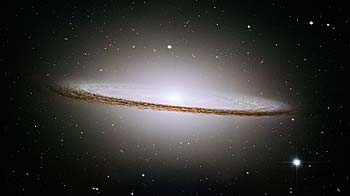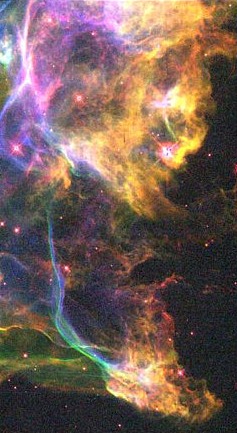
SPACE TODAY ONLINE — COVERING SPACE FROM EARTH TO THE EDGE OF THE UNIVERSE

| STARS | BINARIES | PLANETS | PULSARS | MAGNETARS | BLACK HOLES |
| GALAXIES | MILKY WAY | QUASARS | NEBULAE | THE UNIVERSE | TELESCOPES |
| Astronomy is every bit as important to human life as art, literature, music, culture and human exploration. |
| "Astronomy helps us understand who we are, where we come from, and where we are going. It's human nature to wonder about the big questions. It helps give meaning to our lives." |
| —Dr. Michael West, astronomer, University of Hawai'i, Hilo |
| Source: Ka Leo O Hawai'i, University of Hawai'i, Manoa |
Grains of Sand on a Vast Beach
There are untold trillions of galaxies – clouds of stars, planets, moons, comets, asteroids, gas, dust – strewn across the Universe like grains of sand on a vast beach. From our earliest times we've looked up and wondered what's out there.
Stars. Our Sun is a star. A star is a sphere of hot glowing gas, a single ball of fire in space, often a million of miles or more in diameter.

Hubble Space Telescope records the light arriving at Earth from an exploding star
The stuff of some stars is 10,000 times as thin as Earth's air at sea level. Other stars are so dense a cupful of material would weigh tons on Earth.
Inside, stars have temperatures measured in millions of degrees. At their surfaces, temperatures up to 55,000 degrees are common.
Stars are a long way off, yet all stars visible from Earth, even with telescopes, are within our own Milky Way galaxy. Proxima Centauri, the star nearest Earth, is so far away it's only a pinpoint of light in the largest telescopes on Earth.
Many other stars may be ringed by planets and other small bodies, just as our Sun has its Solar System of planets, moons, comets and asteroids.
Planets reflect starlight, while stars shine with their own light. Stars differ in size, brightness and color.
From our perspective on Earth, stars seem to hold the same positions in the sky year after year. Over many centuries they do appear to move, however, as our Solar System slowly circles the core of our own Milky Way galaxy.
Neighborhood galaxies. A galaxy is a vast island of stars floating through the Universe – millions or billions of stars attracted to each other and held close by their gravity.

Sombrero Galaxy is far away at a distance of 28 million lightyears from Earth. It's not really in our neighborhood.
Astronomers have seen galaxies of many different shapes and sizes. Most common are flat pinwheel spirals, egg-shaped ellipticals, and oddly-shaped irregulars.
The galaxies most widely known are Andromeda Galaxy, Large Magellanic Cloud galaxy and our own Milky Way galaxyWhile astronomers ponder clusters and super-clusters of galaxies, even stranger objects wash up from time to time on the vast beach. Supernovas, neutron stars, pulsars, black holes, quasars and more...
- MILKY WAY. Our Earth circles the Sun which is one star among 100 billion in the Milky Way galaxy.
Viewed from afar, the Milky Way would look like a pinwheel, a spiral, a flat disk 100,000 lightyears in diameter with a bulge at the center.
A lightyear is the distance light travels through space in one year, about 5.9 trillion miles.
- ANDROMEDA. The Andromeda Galaxy, also known as M-31, is the spiral galaxy nearest to our Milky Way and the brightest galaxy in Earth's sky.
Bigger than the Milky Way, it contains 300 billion individual stars in a disk 180,000 lightyears in diameter. Andromeda Galaxy is 2.2 million lightyears from Earth.
- MAGELLANIC CLOUDS. In 1987, the world focused on an irregular galaxy, the Large Magellanic Cloud, when a star in that galaxy exploded into view as the supernova closest to Earth in 400 years. The outburst was labeled Supernova 1987a.
The Large Magellanic Cloud is a galaxy neighbor of our Milky Way galaxy – only 163,000 lightyears from Earth. Light from Supernova 1987a left the Large Magellanic Cloud 163,000 years ago traveling at 186,200 miles per second.
The Large Magellanic Cloud is only 39,000 lightyears in diameter, less than half as wide as the Milky Way.
The Large Magellanic Cloud has a smaller companion galaxy known as the Small Magellanic Cloud. The Small Magellanic Cloud is under 20,000 lightyears in diameter and is 196,000 lightyears from Earth.
Some astronomers have wondered if the Small Magellanic Cloud they see isn't two small galaxies lined up in their telescopes. If so, astronomers would call the third galaxy the Mini Magellanic Cloud. It might be some 230,000 lightyears from Earth.
At any rate, astronomers think the Large Magellanic Cloud may have been closer to Earth once upon a time as it drifted past the Milky Way a billion years ago.
A trail of gas and dust, which astronomers call the Magellanic Stream, extends across our sky. The Magellanic Stream probably is matter ripped away from the Large Magellanic Cloud by Milky Way gravity.
It's not clear whether the Magellanic Clouds are satellite galaxies of the Milky Way, forever circling us, or simply passers-by on a one-time chance encounter as they make their way through the Universe.
Supernovas. Astronomers were riveted when the previously-unremarkable star known as Sanduleak 69.202 exploded in a fiery death as Supernova 1987a.

Cygnus Loop Supernova as seen by the Hubble Space Telescope.
After it blinked into view as the supernova closest to Earth in 400 years, Europeans and Americans checked satellite views of the event. Russians at the orbiting Mir space station photographed it. U.S. and Australian scientists fired rockets, floated instrumented balloons and flew an observatory airplane, all to get as high as possible for a better view of the brilliant Supernova 1987a.
Neutron stars. A supernova is the extraordinarily powerful death explosion of a massive star. The star brightens for a short time, then usually reduces to a small remnant – a neutron star.
Astronomers wonder if a neutron star, maybe even a pulsar, hasn't formed at the heart of Supernova 1987a.
Pulsars. During a supernova explosion, the star collapses inward, explodes, spews out gas and dust, and collapses again into a small heavy core, a neutron star.
If the neutron star spins and radiates energy toward Earth in blips – like a lighthouse beacon – it is referred to as a pulsar.
A pulsar is so crushed by the weight of its own gravity, a thimbleful would weigh a million tons.
Astronomers have been watching one pulsar, 12,000 lightyears from Earth, which has such a regular spin it could replace atomic clocks as our most reliable timepiece. Known by its sky-map location, 1937+21, the pulsar spins at a steady 642 twirls a second.
The official U.S. clock in a laboratory at Boulder, Colorado measures natural vibrations in cesium atoms to mark time. However, they do fluctuate. Pulsar 1937+21, on the other hand, apparently hasn't deviated at all since 1982.
Black holes. At the end of a total collapse of a star or several stars, matter is crushed into a black hole, a very small and extremely massive body, even more densely packed than a neutron star.

Hubble Space Telescope records the beauty surrounding the black hole at the heart of the Circinus Galaxy.
See more images of the beauty in deep space recorded by the Hubble Space Telescope »
It is so dense, its gravity so intense, light can't escape – it's invisible. However, a black hole's presence can be seen in its interaction with normal space around it.
If a black hole sucks matter away from a nearby star, a fountain of X-rays might spew out from the event horizon, the boundary of a black hole.
Other stories: Dying Stars » Diamond Star »
Our black hole. Black holes once seemed to be only faraway objects, but in recent years astronomers have begun to pick up clues that one may be lurking at the heart of our Milky Way galaxy.
It looks like a gargantuan black hole near the core of the Milky Way may be sucking in matter from magnificent dust and gas clouds which obscure our view of the center.
A river of gas, 90 trillion miles long, has been found streaming into the center of the Milky Way. It could be fueling a prodigious black hole at the very heart of the galaxy, according to reports from astronomers who also suspect mini black holes and super-massive black holes are strewn across the Universe.
Quasars. A quasar is a quasi-stellar object, a powerful source of light and natural radio energy. Many have been seen.
They may be highly-luminous galaxies, extremely remote from Earth at the far distant edge of the known Universe, probably undergoing violent explosions.
They may be the most distant objects in the Universe. Quasars are billions of lightyears from Earth, racing farther away at 150,000 miles per second. In their wake, they leave huge quantities of light and other radiation.
Even though they seem smaller than galaxies, some emit 100 times as much energy as common galaxies. They may be violently exploding galaxies or the cores of very active galaxies.
Largest? Observers at the Royal Astronomical Society, London, recently found a cluster of quasars which may be the largest object ever known in the Universe.
The elongated group of 10 to 13 quasars was spotted at a distance of 6.5 billion lightyears from Earth. The cluster measures 650 million lightyears long by 100 million lightyears wide.
Most luminous? British astronomers also have seen what may be the most luminous object ever seen, a massive quasar hiding in a dust cloud at the far edge of the Universe 16 billion lightyears from Earth.
The mysterious body pumps out huge amounts of energy – 300 trillion times more than the Sun and 30,000 times more than our Milky Way galaxy.
Some astronomers suggest the exploding giant originally may have formed into a galaxy shortly after the beginning of time in a Big Bang, itself an explosion which some say created the Universe.
Some say the Universe is only 15-20 billion years old. At 16 billion lightyears from Earth, the puzzling object would be 80 percent of the way back to the Big Bang.
Finding the oldest galaxy has become the Holy Grail of astronomy, one astronomer has said.
RESOURCE: Space Almanac, Second Edition
| STARS | BINARIES | PLANETS | PULSARS | MAGNETARS | BLACK HOLES |
| GALAXIES | MILKY WAY | QUASARS | NEBULAE | THE UNIVERSE | TELESCOPES |